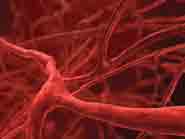Researchers, including Professor Alastair Poole and Dr Matthew Harper from the University of Bristol’s School of Physiology and Pharmacology, have uncovered a key process in understanding how blood clots form that could help pave the way for new therapies to reduce the risk of heart attacks.
The research, carried out in collaboration with researchers from the Universities of Homburg and Heidelberg in Germany, the National Institutes of Health in the USA and University College London, focuses on the action of platelets in the blood clotting process.
These platelets are very small cells in our blood that are essential to blood clotting when we damage a blood vessel. Unfortunately, platelet clots can also block blood vessels in the heart, leading to heart attacks.
When blood vessels are damaged they expose the protein collagen and produce thrombin, which then trigger the platelets to create a clot or thrombus. It has been known for some time that platelets are activated much more strongly if they detect both collagen and thrombin at the same time, but until now it has been a puzzle as how this happens.
Now the research from Bristol and others, which is published today [25 June] in the journal Science Signalling, has shown that platelets respond to simultaneous exposure to these two strong signals by opening a channel in their outer membrane, made up of the proteins TRPC3 and TRPC6.
This channel, which is not opened if platelets detect only one of the damage signals, allows calcium ions to penetrate the platelets and that triggers the platelets to expose a procoagulant surface, which means that they generate more thrombin. This can lead to a vicious cycle of more platelet activation, the generation of more thrombin and bigger clots.
Bristol’s contribution to this research project has been supported by the British Heart Foundation and it’s hoped in the future it could help guide the development of new therapies to control dangerous blood clotting.
